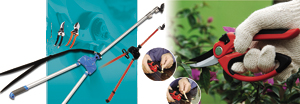Jiin Haur Builds Garden Cutters Featuring Mechanical Advantages
2008/08/14 | By Ken Liu | JIIN HAUR INDUSTRIAL CO., LTDS.B. Wu, chairman of the Jiin Haur Industrial Co., cuts one wooden branch after another into neat pieces, demonstrating how his company's pruner cuts wood like paper.
"This is a fine example of a pair of quality shears," Wu says smugly, "leaving no cracks or chips on the cut ends and is comfy to hold. Most importantly, the two blades should never be forced apart when cutting into the hardest part of a branch."

Developing efficient garden shears has become second nature by now for Jiin Haur, which has been doing so since its establishment in 1977. "All the quality-capable manufacturers in this field know how to tap their abundant experience and dedication," Wu says. "Also, we use 3D computer-aided design (CAD) to optimize mechanical advantages when detailing the configuration of blade tips and pivoting joint-enabling design that transmit shearing forces evenly to blade tips for enhanced cutting efficiency." Insiders also know that CAD would systematically figure out handle-to-blade length ratios to optimize mechanical leverage for easier shearing with such gardening tools.
The biggest maker of gardening cutters in Taiwan, Wu's firm turns out about a million of them in some 40 different categories yearly. Many models are for backyard gardeners, but 70% are designed for professionals and made from imported high-carbon steel to handle the heavy-duty work.
Originally a maker of household scissors, Jiin Haur a few years later diversified into garden cutters. Today it is mostly an original design manufacturer (ODM), a small portion of whose output is marketed under its own "PRAISE" brand.
More than Manufacturing
Jiin Haur is more than a manufacturer apparently: The firm has been granted over 100 patents mostly for ergonomics and exterior design, reflecting its considerable innovation capacity.
One such patented cutter is the JH-605 telescoping lopping shear, said to be the first dual-handle lopping shear in the industry. Most manufacturers, Wu claims, still offer single-handle shears that involve pulling a rope to cut. The JH-605 features improved mechanical efficiency with a gear mechanism at the pivoting joint, while its telescopic arm extends from blade tip to grip-180 to 240 centimeters-enabling excellent reach and makes lopping even 35mm thick branches easy.
Another innovative product is a ratchet pruner that enables on-the-spot lubrication: inside the capped hole of the handle is a tiny oil-soaked sponge.
Other new products that realize Wu's emphasis to integrate user comfort include a pruner with blades that can turn 90 degrees to either side, and a pruner with handles that rotate inward when squeezed for optimize mechanical efficiency-directing shearing forces at maximum, accurately with minimal muscle strain.
A few years ago the company introduced its first power tool: electric hedge shears, which is available either with a telescoping handle or short handle, with both being rechargeable and safety certified according to GS, VDE, UL, and CE standards.
Design Team
Jiin Haur's design team consists of three specialists, including Wu himself, which is backed by computerized hardness testers, mold-building equipment, and 3D CAD tools. The design capability of garden-tool makers in Taiwan, Wu claims, far exceeds the expectations of international buyers. "The most significant design variation is in the grips," he explains. "But however the grips change, they must always feature mechanical advantage or maximized leverage for easier cutting." Though seemingly a minor detail, grip sizes are actually designed to suit varying hand sizes in different markets.
The company invests at least NT$10 million (US$312,000 at NT$32:US$1) in developing molds for five or more new items each year; and ensures quality by using imported steel from Germany, Switzerland, and Japan; with grips and other parts made of non-toxic plastic. Most of Jiin Haur's tools are designed for users in Europe, the United States, Russia, and Southeast Asia; while Asia, Wu reveals, remains a relatively insignificant market for his company.
Offering Quality Pays Off
Offering quality tools has put major retailers on Jiin Haur's list of buyers, who place orders in summer for fall and spring; while big retailers send representatives to inspect Jiin Haur's factory before renewing yearly procurement contracts.
With its 5,610-square-meter operation amidst paddy fields in the central Taiwan county of Changhua, Jiin Haur's setting is deceptively rural as the main glass-screened building contains a showroom and two plants with computerized numerically controlled (CNC) lathes, punching machines, and even an automated warehousing system for storing semi-finished parts.
"Automated machines have cut labor costs by about 30%," Wu comments, "as well as sizably boosting production efficiency. Most importantly, they assure consistent product quality." Wu plans to further cut labor costs by installing automatic feeding machines.
The automatic warehousing system also contributes significantly to raising production efficiency, picking and distributing numerous parts in boxes with nothing but computer commands. In essence, the warehousing system speeds up delivery while reducing inventory risk. Off-the-shelf items have a 30-day lead-time, double that for custom-made items due to molding.
Reduced Manpower
Already, automation has allowed Wu to reduce his workforce from a peak of 50-plus to about 30, with only a few operating the automated machines and the rest responsible for assembling, packaging, and control quality. "Our automated machinery and strict quality control," Wu reports, "have enabled us to reduce our defective rate to nil even prior to the final check."
Carrying the ISO-9001 certification on his shoulders constantly, Wu insists on meeting twice-a-day with his quality control people, who check semi-finished parts at supplier factories, finished products on Jiin Haur's own production lines, and assembled products waiting to be packaged. "Spot-checking won't do, so we check them all," Wu says.




